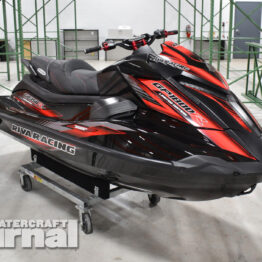There were days when science fiction was the only place where warfare was conducted remotely, as pilots and strategists piloted planes, tanks and even ground troops from darkened control rooms. Today, it’s actually becoming more commonplace. Predator drones infamously patrol territories both foreign and domestic, radio-controlled bomb disposal units disarm explosives and we continue to explore the rugged terrain of Mars from the safety of NASA’s Jet Propulsion Laboratory (JPL) in Pasadena, California.
But how about the open oceans? Believe it or not, BRP Sea-Doo founding family member Charles Bombardier has conceived a sea-faring armored drone to patrol Canada’s Northwest Passage. Powered by much of the same equipment found in the latest RXT-X 260, the autonomous personal watercraft not only could save the Canadian government millions in paying for armed servicemen and women to navigate the treacherous waters, but help deter foreign infiltration.
The proposed SD-44 model (pictured) would be equipped with stabilized aquatic cameras, a powerful LED lights and active illumination technology for evening operations, a strong tow hook to pull or even lift the vehicle out of the water, a quick-connect system attached to a “spring-loaded towing cord or an electric winch. A stronger and more resistant material would be used for the hull and body to make sure the Sea-Drone could sustain impacts from floating ice and the cold weather. Kevlar fibre, for instance, could be a good candidate and there are other ways to beef up the hull.”
No plans have been made to arm the Sea-Done, so don’t expect a Sea-Doo powered miniature battleship invading your urban shoreline any time soon. Below you’ll find the original proposal by Charles Bombarier outlining the Sea-Done’s capabilities and possible usefulness to the Canadian Navy.
______________________
The concept
The Sea-Drone is an autonomous personal watercraft (PWC) concept designed to patrol the Canadian Arctic. It would roam open waters directed by a control and command center. The units would be deployed from Canadian icebreakers or Navy ships.
The background
Not long ago the Northwest Passage – a sea route through the Arctic Ocean, along the northern coast of Canada featuring multiple waterways – became a viable route for ships. In the coming year the country will likely need to explore and occupy this remote territory and use special robotic units such as the Sea-Drone to reduce risk and optimize surveillance operations.
How it works
The Sea-Drone would be based on an existing Sea-Doo model such as the RXT-X-260, but it wouldn’t have any seats or steering since it would be a robotic watercraft. It could operate autonomously or be piloted remotely.
Multiple versions were designed, and all of them are equipped with a stabilized aquatic camera, a powerful LED light and active illumination technology for evening operations.
The stabilized sea-worthy cameras would record video and images from other ships and relay them across the world by satellite or to a cell tower mounted on the main ship. The purpose of the drone would be to identify intruders and relay the video feed to the command centre.
At the front of each craft there would be a strong tow hook to pull or even lift the vehicle out of the water. At the back there would be a quick connect system attached to a spring-loaded towing cord or an electric winch. A Sea-Drone would be able to back up near another unit in distress and bring it back to the main ship or tow small boats.
A stronger and more resistant material would be used for the hull and body to make sure the Sea-Drone could sustain impacts from floating ice and the cold weather. Kevlar fibre, for instance, could be a good candidate and there are other ways to beef up the hull.
The SD-44 model, pictured, was designed with this in mind. The SD-88 model was created with packaging in mind. The marine camera could be be lowered inside the hull and units could be stacked on top of each other.
What it’s used for
The Sea-Drone would go out on two-hour patrol missions to look behind all the hidden channels and islands where the command and control ship would not venture. It could also serve to deter other ship from venturing in restricted waters. The Sea-Drone could carry an extra fuel tank or various loads such as radar sensors, military and rescue equipment.
The designer
The Sea-Drone renderings were produced by Matt Betteker, who is located in South Jultland, Denmark. He studied at the College for Creative Studies and he works as a senior designer for Lego.

















If they never pay, the us government isn’t getting the
revenue, therefore, they want someone to collect that money for the children,
thus, doing their job on their behalf. Ask for their physical
office address – be leery of contractors who have only a P.
Many roofing materials have a very warranty from
the manufacturer, thus you should just be sure to buy the ones that do.